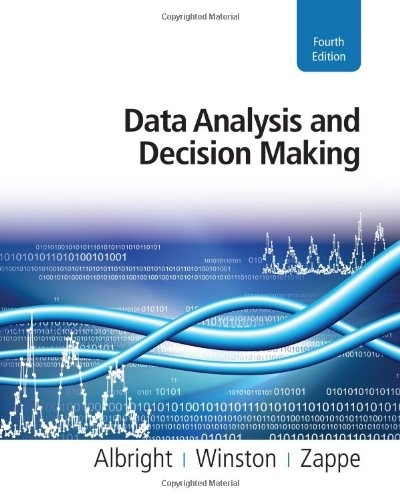Instant download Data Analysis and Decision Making Albright 4th Edition Solutions Manual pdf docx epub after payment.

Product details:
- ISBN-10 : 0538476125
- ISBN-13 : 978-0538476126
- Author:S. Christian Albright; Wayne L. Winston
DATA ANALYSIS AND DECISION MAKING is a teach-by-example approach, learner-friendly writing style, and complete Excel integration focusing on data analysis, modeling, and spreadsheet use in statistics and management science. The Premium Online Content Website (accessed by a unique code with every new book) includes links to the following add-ins: the Palisade Decision Tools Suite (@RISK, StatTools, PrecisionTree, TopRank, RISKOptimizer, NeuralTools, and Evolver); and SolverTable, allowing users to do sensitivity analysis. All of the add-ins is revised for Excel 2007 and notes about Excel 2010 are added where applicable. About This Edition New Features Chapters 2 and 3 are completely rewritten and reorganized, focusing on the description of one variable at a time, and relationships between variables. Both chapters have more coverage of categorical variables, as well as new and more interesting data sets in the examples. Many of the problems in previous editions were deleted or updated, and a number of brand new problems were added for relevance to current statistical analysis. A problem guide is available to instructors showing the context of each of the “data” problems, and it also shows the correspondence between problems in this edition and problems in the previous edition. The previous edition’s Chapter 4 is renamed Chapter 17, “Importing Data into Excel,” and is completely rewritten with its section on Excel tables located in Chapter 2. (Previous edition chapters 5-17 were renumbered 4-16.) The book is still based on Excel 2007, but notes about changes in Excel 2010 have been added where they apply.
Table of contents:
1. Introduction to Data Analysis and Decision Making. 1.1. Introduction. 1.2. An Overview of the Book. 1.3. Modeling and Models. 1.4. Conclusion. PART I: EXPLORING DATA.
2. Describing the Distribution of a Single Variable. 2.1 Introduction. 2.2 Basic Concepts. 2.3 Descriptive Measures for Categorical Variables. 2.4 Descriptive Measures for Numerical Variables. 2.5 Time Series Data. 2.6 Outliers and Missing Values. 2.7 Excel Tables for Filtering, Sorting, and Summarizing. 2.8 Conclusion.
3. Finding Relationships Among Variables. 3.1 Introduction. 3.2 Relationships Among Categorical Variables. 3.3 Relationships Among Categorical Variables and a Numerical Variable. 3.4 Relationships Among Numerical Variables. 3.5 Pivot Tables. 3.6 An Extended Example. 3.7 Conclusion. PART II: PROBABILITY AND DECISION MAKING UNDER UNCERTAINTY
4. Probability and Probability Distributions. 4.1. Introduction. 4.2. Probability Essentials. 4.3. Distribution of a Single Random Variable. 4.4. An Introduction to Simulation. 4.5. Distribution of Two Random Variables: Scenario Approach. 4.6. Distribution of Two Random Variables: Joint Probability Approach. 4.7. Independent Random Variables. 4.8. Weighted Sums of Random Variables. 4.9. Conclusion.
5. Normal, Binomial, Poisson, and Exponential Distributions. 5.1. Introduction. 5.2. The Normal Distribution. 5.3. Applications of the Normal Distribution. 5.4. The Binomial Distribution. 5.5. Applications of the Binomial Distribution. 5.6. The Poisson and Exponential Distributions. 5.7. Fitting a Probability Distribution to Data with @RISK. 5.8. Conclusion.
6. Decision Making Under Uncertainty. 6.1. Introduction. 6.2. Elements of a Decision Analysis. 6.3. The PrecisionTree Add-In. 6.4. Bayes’ Rule. 6.5. Multistage Decision Problems. 6.6. Incorporating Attitudes Toward Risk. 6.7. Conclusion. PART III: STATISTICAL INFERENCE.
7. Sampling and Sampling Distributions. 7.1. Introduction. 7.2. Sampling Terminology. 7.3. Methods for Selecting Random Samples. 7.4. An Introduction to Estimation. 7.5. Conclusion.
8. Confidence Interval Estimation. 8.1. Introduction. 8.2. Sampling Distributions. 8.3. Confidence Interval for a Mean. 8.4. Confidence Interval for a Total. 8.5. Confidence Interval for a Proportion. 8.6. Confidence Interval for a Standard Deviation. 8.7. Confidence Interval for the Difference Between Means. 8.8. Confidence Interval for the Difference Between Proportions. 8.9. Controlling Confidence Interval Length. 8.10. Conclusion.
9. Hypothesis Testing. 9.1. Introduction. 9.2. Concepts in Hypothesis Testing. 9.3. Hypothesis Tests for a Population Mean. 9.4. Hypothesis Tests for Other Parameters. 9.5. Tests for Normality. 9.6. Chi-Square Test for Independence. 9.7. One-Way ANOVA. 9.8. Conclusion. PART IV: REGRESSION ANALYSIS AND TIME SERIES FORECASTING.
10. Regression Analysis: Estimating Relationships. 10.1. Introduction. 10.2. Scatterplots: Graphing Relationships. 10.3. Correlations: Indicators of Linear Relationships. 10.4. Simple Linear Regression. 10.5. Multiple Regression. 10.6. Modeling Possibilities. 10.7. Validation of the Fit. 10.8. Conclusion.
11. Regression Analysis: Statistical Inference. 11.1. Introduction. 11.2. The Statistical Model. 11.3. Inferences About the Regression Coefficients. 11.4. Multicollinearity. 11.5. Include/Exclude Decisions. 11.6. Stepwise Regression. 11.7. The Partial F Test. 11.8. Outliers. 11.9. Violations of Regression Assumptions. 11.10. Prediction. 11.11. Conclusion.
12. Time Series Analysis and Forecasting. 12.1. Introduction. 12.2. Forecasting Methods: An Overview. 12.3. Testing for Randomness. 12.4. Regression-Based Trend Models. 12.5. The Random Walk Model. 12.6. Autoregression Models. 12.7. Moving Averages. 12.8. Exponential Smoothing. 12.9. Seasonal Models. 12.10. Conclusion. PART V: OPTIMIZATION AND SIMULATION MODELING.
13. Introduction to Optimization Modeling. 13.1. Introduction. 13.2. Introduction to Optimization. 13.3. A Two-Variable Product Mix Model. 13.4. Sensitivity Analysis. 13.5. Properties of Linear Models. 13.6. Infeasibility and Unboundedness. 13.7. A Larger Product Mix Model. 13.8. A Multiperiod Production Model. 13.9. A Comparison of Algebraic and Spreadsheet Models. 13.10. A Decision Support System. 13.11. Conclusion.
14. Optimization Models. 14.1. Introduction. 14.2. Worker Scheduling Models. 14.3. Blending Models. 14.4. Logistics Models. 14.5. Aggregate Planning Models. 14.6. Financial Models. 14.7. Integer Programming Models. 14.8. Nonlinear Programming Models. 14.9. Conclusion.
15. Introduction to Simulation Modeling. 15.1. Introduction. 15.2. Probability Distributions for Input Variables. 15.3. Simulation and the Flaw of Averages. 15.4. Simulation with Built-In Excel Tools. 15.5. Introduction to the @RISK Add-in. 15.6. The Effects of Input Distributions on Results. 15.7. Conclusion.
16. Simulation Models. 16.1. Introduction. 16.2. Operations Models. 16.3. Financial Models. 16.4. Marketing Models. 16.5. Simulating Games of Chance. 16.6. An Automated Template for @RISK Models. 16.7. Conclusion. PART VI: BONUS ONLINE MATERIAL 2 Using the Advanced Filter and Database Functions.
17. Importing Data into Excel. 17.1 Introduction. 17.2 Rearranging Excel Data. 17.3 Importing Text Data. 17.4 Importing Relational Database Data. 17.5 Web Queries. 17.6 Cleansing the Data. 17.7 Conclusion.
People also search:
Data Analysis and Decision Making Albright 4th Edition Solutions Manual
Data Analysis and Decision Making Albright 4th Edition Solutions Manual
Data Analysis and Decision Making Albright Winston Zappe 4th Edition Solutions Manual
Data Analysis and Decision Making Albright Winston Zappe 4th Edition Solutions Manual





